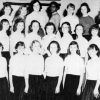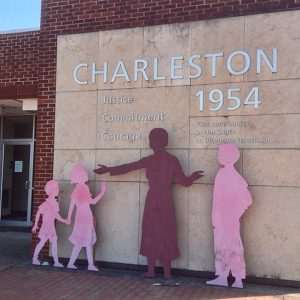calsfoundation@cals.org
Desegregation of Charleston Schools
Much has been written about the Little Rock School District desegregation in 1957. However, the Charleston Public School District quietly and successfully integrated first through twelfth grades, without any publicity until about three weeks after school had opened for the fall term in 1954. Charleston was the first school district in the former Confederate states to integrate all twelve grades, and because of this, Charleston School District has been named a National Commemorative Site by the U.S. Department of the Interior National Park Service.
Following the May 17, 1954, U.S. Supreme Court decision in Brown v. Board of Education of Topeka, Kansas that deemed state laws mandating public school segregation unconstitutional under the equal protection clause of the Fourteenth Amendment, the Charleston School Board made a historic decision. In the spirit of civic obedience, on July 27, 1954, the five-member board—consisting of President Howard Madison Orsburn, George Ferrell Hairston, Archibald R. Schaffer, Herbert E. Shumate, and Homer Keith—voted unanimously to “disband the Colored School and admit the Colored children into the grade and high school when classes open for the fall semester.”
When the fall semester opened on August 23, 1954, in the small town of Charleston (Franklin County), located in western Arkansas about twenty miles east of Fort Smith (Sebastian County) on Highway 22, eleven African-American students attended classes with some 480 white students. Three were enrolled in the ninth grade and eight in the elementary grades. Those outside of the town were unaware that this small school district had made history.
Following the May U.S. Supreme Court ruling, the Charleston School Board and Woodrow W. Haynes, superintendent of Charleston Public Schools spent the early part of the summer persuading civic and business leaders, including the local newspaper, not to discuss the integration plans with any out-of-town news source. The story was not reported to the media until September 13, 1954, by which time black students had been admitted to Fayetteville High School in Washington County. On this same day, Charleston School Board president Howard Madison Orsburn revealed to reporters that Charleston schools had integrated peacefully three weeks earlier. The secrecy surrounding the event may have saved Charleston from the problems that plagued other school districts during the early years of integration.
Economics, not just morality, also played a role in Charleston’s decision to desegregate. Prior to the 1954 integration, the district had paid around $4,500 a year to enroll, transport, and pay expenses for black high school students sent to the all-black Lincoln High School in Fort Smith. The local Rosenwald School provided education for first through eighth grade and was the Charleston black community’s first tax-supported school, but black students wanting to graduate from high school had to be transported to Fort Smith. The 1954 integration decision closed the Rosenwald School, which needed repairs the district could not afford, and removed the necessity of transporting the ninth-through-twelfth-grade students to Fort Smith.
Early in the morning of the first day of classes, August 23, 1954, Superintendent Haynes found a racial slur written on an outside school wall. Determined to achieve a successful merger, he and the janitor cleaned it off prior to the arrival of the students, and no one else saw it. There were, however, a few repercussions from Charleston’s integration. Some schools refused to play Charleston in football because black students were on the team. Also, Charleston was excluded from some band competitions because of black members.
On June 26, 1958, Superintendent Haynes had announced his departure from Charleston, his home town, for a college administrative position in northeast Arkansas. At the July 5 meeting, Schaffer, a member of the school board since 1949, resigned effective July 1, 1958. Orsburn, who had served on the board for many years, also resigned effective the same date. Dale Bumpers, future U.S. senator, and Gene VanMeter were appointed to fill the un-expired positions of Schaffer and Orsburn.
In the fall of 1957, the worldwide publicity surrounding the desegregation of Central High School in Little Rock (Pulaski County) bolstered the determination of a very small group of Charleston segregationists to reverse the 1954 integration. They organized and selected two candidates to run for the school board positions that had become vacant, and they campaigned and advertised extensively. The segregationists’ hopes were extinguished when they were overwhelmingly defeated by a 2-1 margin in the December 6, 1958, election.
The first two black graduates of Charleston High School were Barbara (Williams) Dotson and Joe Ferguson in 1961. Charleston High School was designated as a National Commemorative Site through legislation authored by Senator Bumpers in 1998, prior to his retirement. Interpretative exhibits, both inside and outside of the Annex Building, which is located on the east end of the school campus, tell the story of the school desegregation. A National Park sign is in front of the building at curbside on the south side of Main Street. The present-day Charleston School District serves a diverse population that includes students of various races and ethnicities.
For additional information:
Doing What Was Right. VHS. TeleVision for Arkansas, 2004.
Hughes, David. “At long last, integration of ’54 to go on the map.” Arkansas Democrat-Gazette. November 15, 1998, pp. 1B, 7B.
Mary Belle Ervin
Charleston High School
 Civil Rights and Social Change
Civil Rights and Social Change Education, Elementary and Secondary
Education, Elementary and Secondary School Desegregation Timeline
School Desegregation Timeline World War II through the Faubus Era, 1941 through 1967
World War II through the Faubus Era, 1941 through 1967 Dale Bumpers
Dale Bumpers  Charleston Desegregation Exhibit
Charleston Desegregation Exhibit 



Comments
No comments on this entry yet.